Following is an excerpt from a report in Telegraph.
New Delhi, Jan. 16: President Pratibha Patil has promulgated an ordinance allowing the government to establish 15 new central universities despite last-minute objections by the National Knowledge Commission that the ordinance would hurt higher education.
The President signed the ordinance late last night even as the commission headed by Sam Pitroda tried to convince the Prime Minister and senior government officials against the move.
Patil’s signature triggered a chain of events today that saw the human resource development ministry launch a process of selection of vice-chancellors within hours.
It has also set off fireworks between the commission and the ministry, which the commission believes is keen to retain control over universities while officially calling them autonomous.
… The government is keen to start classes at the universities in the 2009 academic session, said the ministry note to the President.
The ministry, a top HRD official said, will bring the ordinance before both Houses when Parliament meets briefly in February. “We want the ordinance to be cleared by both Houses in the narrow slot for which the Parliament is meeting so that we can start classes from 2009,” the official said.
An ordinance needs parliamentary ratification within six months.
One of the above mentioned 15 universities will be in Orissa; Earlier the Orissa government recommended the Koraput area as the site of this university. As per the bill, available here, the one in Orissa will be called Central University of Orissa.
An earlier copy of the bill (before Goa University was taken out) is available here. There was last minute criticism of the bill and request to not promulgate it as an ordinance by the National Knowledge Commission. See news reports on this here and here. But the President promulgated the ordinance anyway.
January 18th, 2009
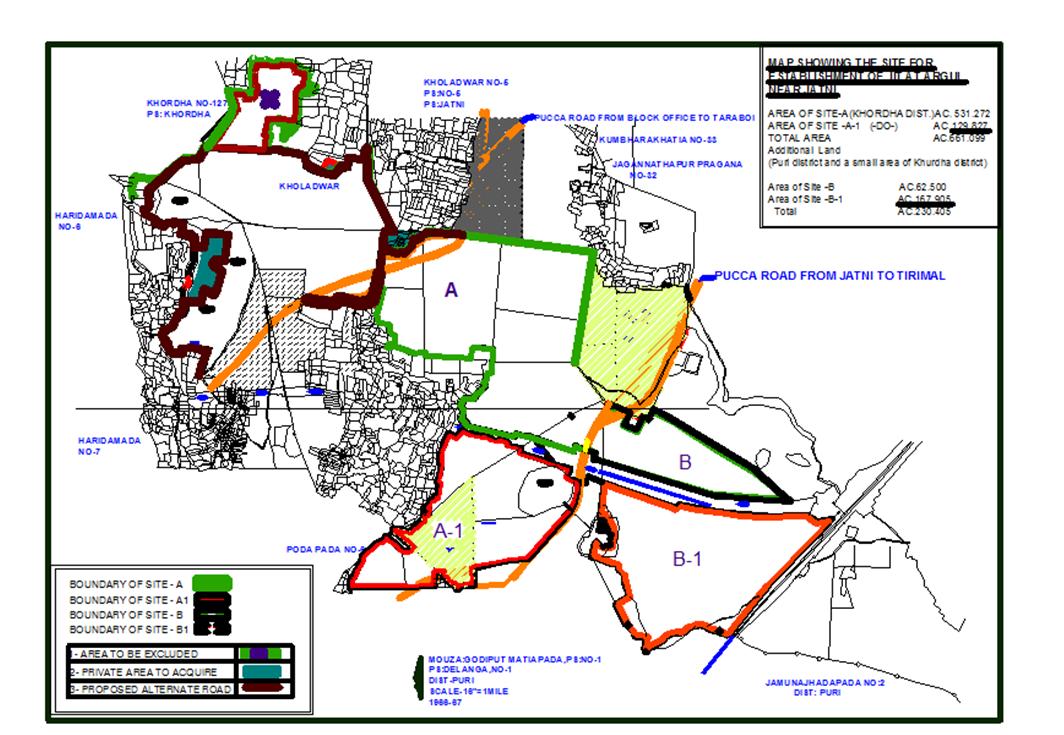
January 17th, 2009
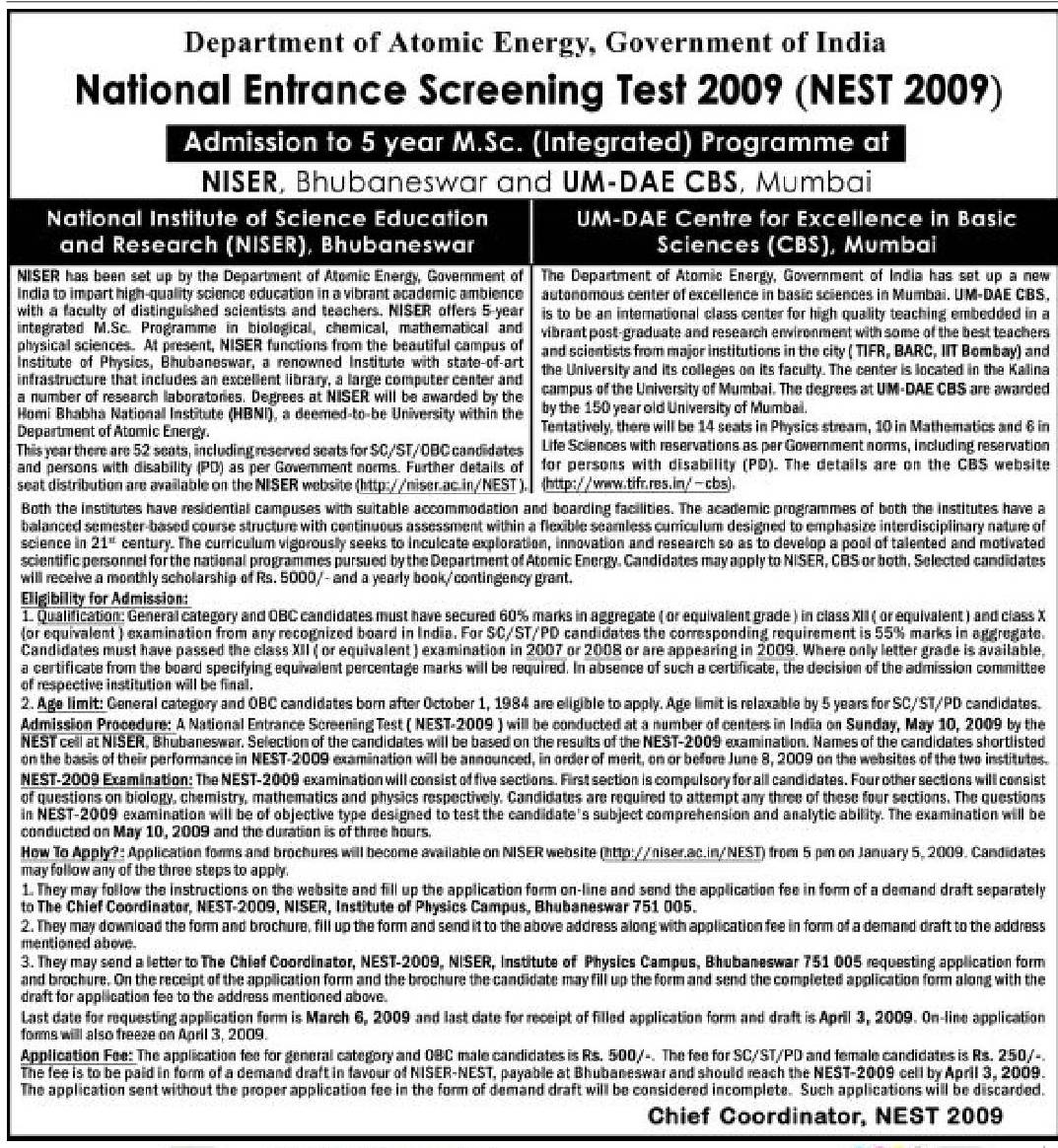
Unlike the IISERs that take students from the IIT exams and KVPY, NISER Bhubaneswar (an IISER-equivalent institute that is funded by DAE) teams up with UM-DAE and has its own exam called NEST. (They also took students from KVPY.)
The following information regarding NEST 2009 is from http://niser.ac.in/NEST/.
About NEST
National Entrance Screening Test (NEST) is a compulsory test for students seeking admission to National Institute of Science Education and Research (NISER), Bhubaneswar and University of Mumbai – Department of Atomic Energy Centre for Excellence in Basic Sciences (UM-DAE CBS), Mumbai. Both NISER and UM-DAE CBS have been started by Department of Atomic Energy, Government of India in 2007. Their mandate is to train scientific manpower for carrying out cutting edge scientific research and for providing input to scientific programs of Department of Atomic Energy and other applied science institutions in the country. The test is conducted in more than 25 centers across India. This brochure gives the detailed procedure for applying for the test, syllabus of the test and various dead lines.
NEST Brochure 
About NISER
NISER has been set up by the Department of Atomic Energy, Government of India to impart high-quality science education in a vibrant academic ambience with a faculty of distinguished scientists and teachers. NISER offers 5-year integrated M.Sc. programme in biological, chemical, mathematical and physical sciences. At present, NISER functions from the beautiful campus of
Institute of Physics, Bhubaneswar, a renowned Institute with state-of-art infrastructure that includes an excellent library, a large computer center and a number of research laboratories. Degrees at NISER will be awarded by the Homi Bhaba National Institute (HBNI), a deemed-to-be University within the department of Atomic energy.
This year there are 52 seats, including reserved seats for SC/ST/OBC candidates and persons with disability (PD) as per Government norms. Further details about the institute can be found on the NISER website (http://niser.ac.in).
NISER Brochure 
About UM-DAE CBS
The Department of Atomic Energy, Government of India has set up a new autonomous center of excellence in basic sciences in Mumbai. UM-DAE CBS, is to be an international class center for high quality teaching embedded in a vibrant post-graduate and research environment with some of the best teachers and scientists from major institutions in the city (TIFR, BARC, IIT Bombay) and the University and its colleges on its faculty. The center is located in the Kalina campus of the University of Mumbai. The degrees at UM-DAE CBS are awarded by the 150 year old University of Mumbai.Tentatively, there will be 14 seats in Physics stream, 10 in Mathematics and 6 in Life Sciences with reservations as per Government norms, including reservation for persons with disability (PD). The details are on the CBS website (http://www.tifr.res.in/~cbs).
Important Dates
- Last date for request of application form : March 6, 2009
- Last date for receipt of completed application form with DD : April 3, 2009
- Online applications freeze : April 3, 2009
- Dispatch of offline admit cards begins : April 15, 2009
- Download of online admit cards begins : April 15, 2009
- Date of examination : May 10, 2009 (Sunday), 1 pm to 4 pm
- Announcement of results on NEST website : June 8, 2009
Eligibility for appearing NEST
Students securing at least 60% marks in aggregate (or equivalent grade) in Class XII (or equivalent) examination from any recognized Board in India are eligible to apply. For Scheduled Cast (SC), Scheduled Tribes (ST) candidates and for Persons with Disability (PD), the minimum requirement is 55%. Students who have passed the Class XII qualifying examination in 2007 or 2008 or are appearing in 2009 are eligible to apply. (Where only Letter grade is given by the Board, a certificate from the Board specifying equivalent percentage marks will be required. In the absence of such a certificate the decision of the respective Admissions Committee will be final.)
How to apply (3 ways)
- Online form submission is the most convenient and preferred way. Follow these steps to go for it.
- Register yourself before you login.
- Confirm your registration from a mail sent to you just after registration.
- Login in the NEST homepage with your mail-id and password.
- Fill the form and save it or, modify an already saved form.
- Take the print-out and send along with DD.
- Form can be downloaded, filled and sent back with DD. Download form NEST Brochure Please set margin in the browser page-setup to accomodate the form in a single A4 sheet.
- A letter of request can be sent to get the printed form by post. This form will have to be sent back along with DD after filling it properly.
January 13th, 2009
Following is from the PTI report on this.
The government today approved an area of 935 acres near Jatni in Khurda district of Orissa as the site for the proposed IIT in the state.
"There were four possible sites for the top institute. But the government approved the location near Jatni as it has vast land area and is near to airport. The rail and road connectivity is very good to this place," a top HRD Ministry official told PTI here.
HRD Minister Arjun Singh will visit the state soon to lay the foundation stone for the elite technical institute, the official said.
He said the ministry had sent its site identification committee to the state on December 24 and 25 last year. The committee visited the sites near Jatni, Banki, Ramdaspur and Gayabandha.
"Among all the places, the committee found location near Jatni was the best from the point of view of future and growth prospects of the institute," he said.
… "The Centre also asked the state government to transfer the land to the IIT Society of IIT Bhubaneswar immediately so that the construction of the building and other facilities can be started," he said.
January 13th, 2009
Following is from http://pib.nic.in/release/release.asp?relid=46517.
Shri G K Vasan, Minister of State (Independent charge), Ministry of Statistics & Programme Implementation said that the Government of India has plans for setting up three new universities for the benefit of the children of NRIs and PIOs. While addressing at the Regional Session on Carribean at the 7th Pravasi Bharatiya Divas, 2009 today at Chennai, he informed that the first of these universities to be located at Bangalore is expected to be operational by the year 2010. These universities would have a reservation of 50 per cent seats for NRIs and PIOs. The Government has also increased the number of scholarships to 120 to facilitate unhindered access to higher education for children of NRIs and PIOs who are not economically well off in their adopted lands, the Minister added.
January 10th, 2009
Following is from http://pib.nic.in/release/release.asp?relid=46323.
The Cabinet Committee on Economic Affairs today gave its approval for a new Centrally sponsored Scheme by the name of National Mission on Education through Information and Communication Technology (ICT) submitted by the Ministry of HRD.
An amount of Rs.4612 crore is to be incurred during the 11th Five Year Plan for the National Mission on Education through ICT. There is a budget provision of Rs.502 crore during the current financial year 2008-09.
The National Mission on Education through ICT has been envisaged as a Centrally sponsored Scheme to leverage the potential of ICT, in providing high quality personalized and interactive knowledge modules over the internet/intranet for all the learners in Higher Education Institutions in any time any where mode. This is expected to be a major intervention in enhancing the Gross Enrolment Ratio (GER) in Higher Education by 5 percentage points during the XI Five year Plan period and in ensuring access and equity in Higher Education, as also recommended by the Oversight Committee and the National Knowledge Commission. The Mission has two major components viz., (a) content generation and (b) connectivity along with provision for access devices for institutions and learners. It seeks to bridge the digital divide, i.e. the gap in the skills to use computing devices for the purpose of teaching and learning among urban and rural teachers/learners in Higher Education domain and empower those, who have hitherto remained untouched by the digital revolution and have not been able to joint the mainstream of the knowledge economy. It plans to focus on appropriate pedagogy for e-learning, providing facility of performing experiments through virtual laboratories, on-line testing and certification, on-line availability of teachers to guide and mentor learners, utilization of available Education Satellite (EduSAT) and Direct to Home (DTH) platform, training and empowerment of teachers to effectively use the new method of teaching learning etc.
The Mission shall work in close cooperation and collaboration with other Missions/Schemes such as the National Translation Mission, Vocational Education Mission, National Knowledge Network, Scheme of ICT @ Schools etc., to avoid any duplication and attain synergy. It would operate through inter-departmental and multi-disciplinary approach. On the one hand, the Mission would create high quality e-content for the target groups and on the other, it would simultaneously extend computer infrastructure and connectivity to over 18000 colleges in the country including each of the departments of 419 universities/deemed universities and institutions of national importance on a single point rental basis through the Department of Telecommunications (DOT), in a manner that would permit their seamless interaction with a integrated National Knowledge Network. The advent of very low-cost-low-power consuming access cum computing devices, would further enhance the reach of the network. The peer group assisted content development would utilise the wikipaedia type of collaborative platform under the supervision of a content advisory committee responsible for vetting the content. Interactivity and problem solving approach would be addressed through “Talk to a Teacher” segment. The Mission would also have a component of Teacher Empowerment through proper training and digital literacy of teachers to be able to use the e-contents. Renowned institutions would anchor various activities in their areas of excellence. The Mission would seek to enhance the standards of education, in Government as well as in private colleges. Enlistment of support and cooperation of States/Union Territories, Institutions and individual experts would be an integral part of the Mission.
The Mission will ensure that there is no duplication with National Knowledge Network. It will also cater to contents for higher education sector. National Programme of Technology enhanced Learning (NPTEL) Phase II and III will be part of the generation activity.
The Mission would have a three tier committee system to monitor and guide its functioning. The apex National Committee would be chaired by Hon’ble Minister of Human Resource Development. It would decide on all policy and administrative issues and prescribe guidelines for the functioning of the two sets of Committees namely ‘Empowered Committee of Experts (henceforth shall be called as ‘Project Approval Board’) would be sanctioning individual projects and monitoring the overall progress through various peer reviews and concurrent evaluation.
Ministry of HRD, Deptt. of Higher Education would enter into MoU with State Governments for proper monitoring of the Scheme in their State and contribute 50% of the cost of hardware and 25% of the cost of connectivity in respect of the colleges/institutions/universities maintained or substantially funded by it. Similar MoU would also be entered into with Mentor institutions for private/self-financing colleges/institutions/universities for ensuring that the beneficiary institutions contribute 50% of the cost of hardware and 25% of the cost of connectivity and maintain and sustain the facility created under the Scheme after expire of 5 years.
The projected benefits/results of the Scheme would be enhancement of access to quality education, making available knowledge modules in cyber space and optimal utilization of available resources by using of ICT for educating the masses, especially those inhibited in remotely located areas and places at disadvantage.
*****
AD/SH/LV
January 3rd, 2009
He was previously at the MHRD. See here.
Bata Kishore Ray/
(Asst Financial Adviser) |
234-C Shastri BhavanDr. Rajendra Prasad RoadDelhi
Pin: – 110001
Tel: – 23388608Fax: – 23388608
Category – Central Secretariat Services
Organisation – Ministry of Human Resource Development
Email – bkray@nic.in |
January 1st, 2009
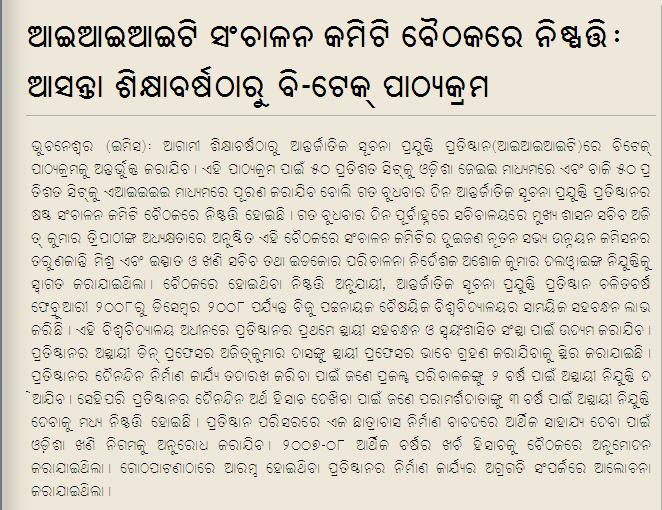
December 26th, 2008
Update: Excerpts from a report in Kalinga Times.
Aragul near Jatni has been finally chosen as the place for setting up of the Indian Institute of Technology, Bhubaneswar.
A four-member Central team sent by the Union Ministry of Human Resource Development selected Aragul after visiting four different places.
The team comprised Ashok Thakur, Additional Secretary in the Union Ministry of Human Resource Development; Damodar Acharya, Director of IIT Kharagpur; A.K. Dey, former Director of IIT Mumbai; and K. Narayan Rao, Secretary of All-India Council for Technical Education (AICTE).
The place selected is 12 km from Bhubaneswar airport by road and four km away from Jatni railway junction.
Following are excerpts from a report in tathya.in.
Ashok Thakur is impressed with Argul.
The Chairman of the Site Selection Committee for the IIT-Bhubaneswar found the site near Jatni a ‘nice’ one.
… The State Government has identified Argul near Jatni and Malipada near Khurda.
Both are in Khurda district.
Secondly Ramdaspur near Naraj and Dampada near Banki in Cuttack district were also identified for the purpose.
Mr.Thakur himself visited Argul on 25 December and expressed satisfaction over the place, said sources.
It is 891 acre of land out of which 500 acres are readily available.
Very near to the Capital city and well connected with rail and road.
Institutions like NISER, various engineering colleges and other institutions are coming up in the near by area.
This place was favored by the State Government for the IIT-Bh as the most suitable one.
It looks very likely that Argul will be chosen for the IIT site. But the others sites would soon come into play; especially for the world class central university (national university).
December 25th, 2008
(This is inspired by the post http://iitbbs.blogspot.com/2008/12/latest-news.html.)
The IIT Bhubaneswar will be temporarily located in the IIT Kharagpur Extension Center. It is located 1km from the NH-5 Jaydev Vihar exit towards Nandan Kanan. It is behind Ginger hotel and Swosti Plaza hotel. Across these two hotels is the Trident Oberoi and about 300 mts away is the Mayfair lagoon Hotel. Each of these hotels have many nice restaurants. About 700 mts from IIT location is the Pal Heights shopping complex that has a very good restaurant as well as an Oxford book store. About 500 mts the other direction is the Sandy’s Square which has a Smoking Joes Pizza.
Next to the IIT location is the Shyamasam Dham, one of the Main Ashrams of Jagadguru Kripalu Parishat.
About 150-200 mts to the IIT location is Gandhi Park and Janata Maidan. The later can be a ground to play outdoor games such as Cricket, Football and Hockey.
The IIT location is in the North east corner of the large Institute of Mineral and Materials Technology (formerly RRL) campus. It is expected that the IIT students will have access to this campus and some of its amenities including its outdoor playing areas. The Kalinga Stadium and its swimming pool is about 1.5 kms from the IIT location.
The Maharaja theater is 2 kms away. XIMB (Basketball, Tennis courts, Football ground, auditorium) is 600 mts away. Institute of Physics is 700 mts away. Utkal University is 1 km away.
The ESI Hospital is about 250 mts from the IIT location and Kalinga Hospital is about 1 kms away. (Next to Kalinga Hospital is the Institute of Life Sciences and Regional Medical research Center).
Following are some maps. In the maps with one big red dot, the dot indicates the location of the temporary campus of the IIT Bhubaneswar. In the maps with two red marks, the larger mark indicates the expected permanent location of IIT Bhubaneswar.
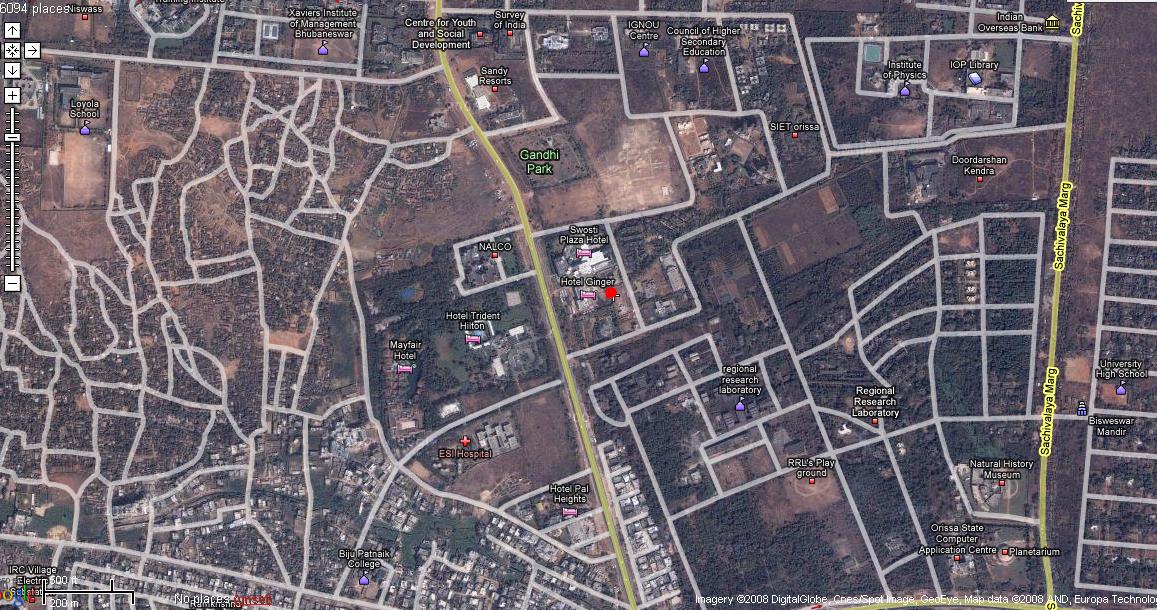
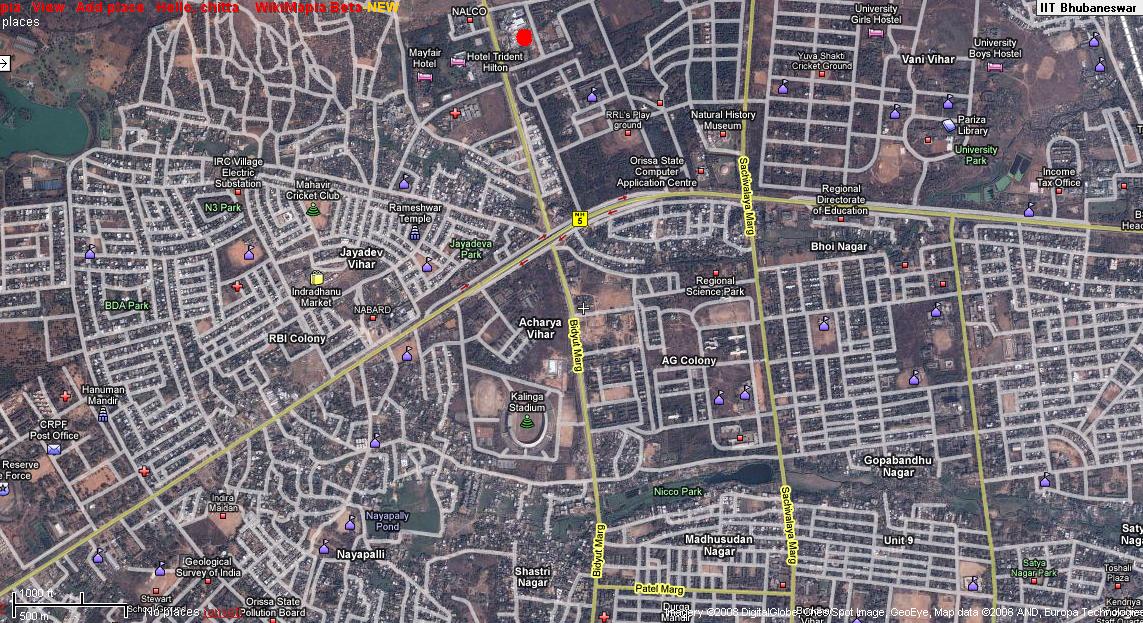
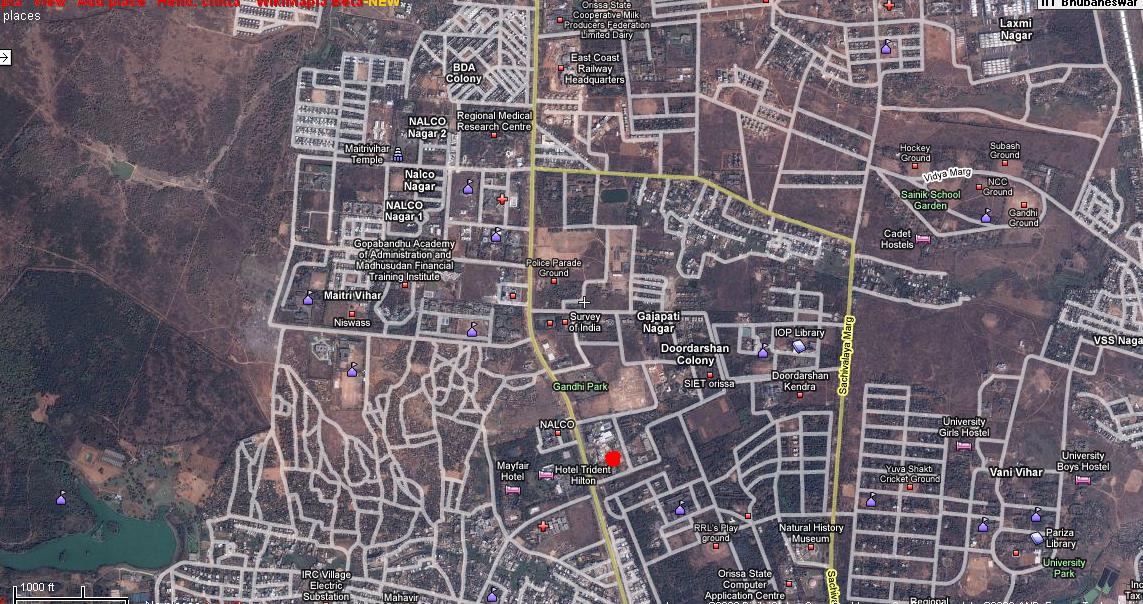
.jpg)
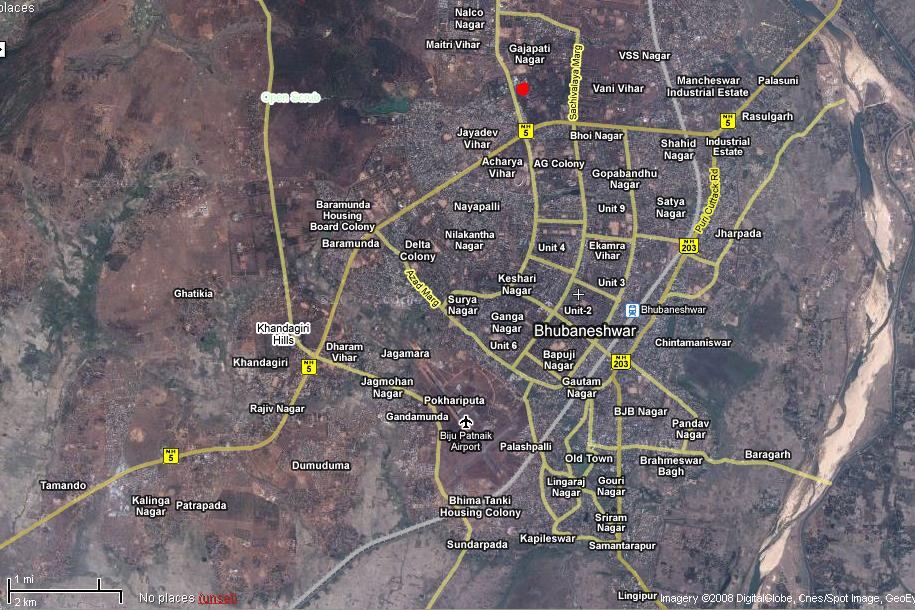
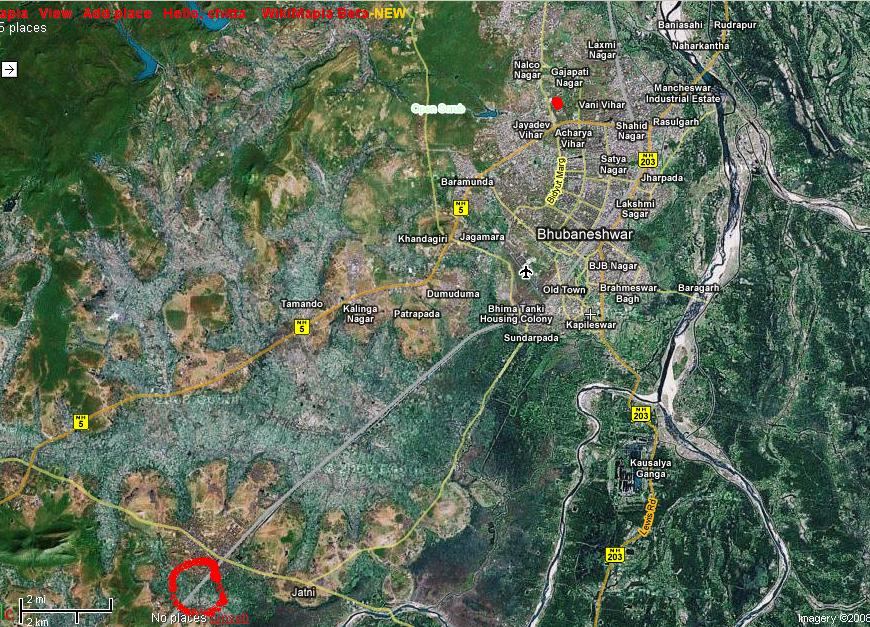
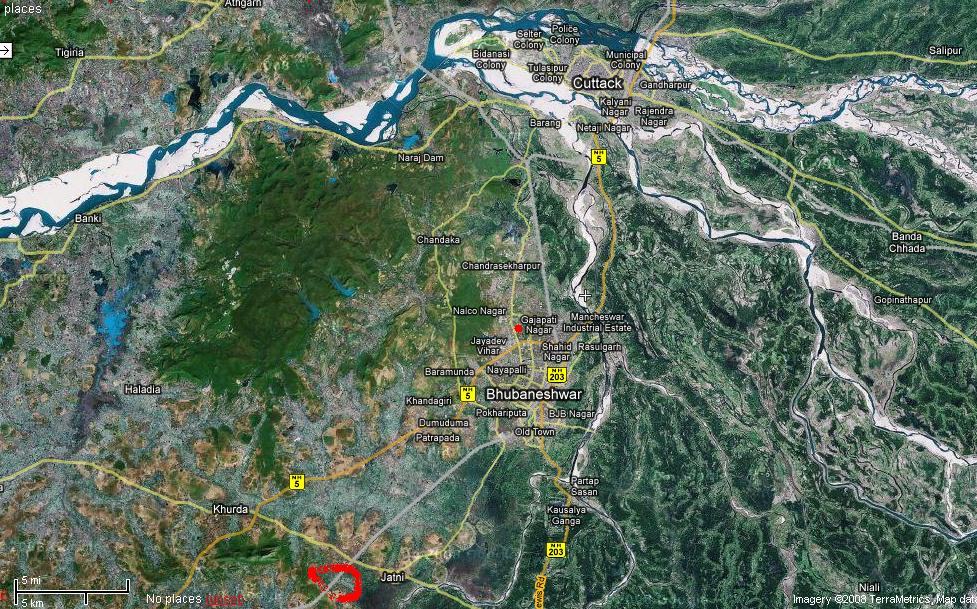
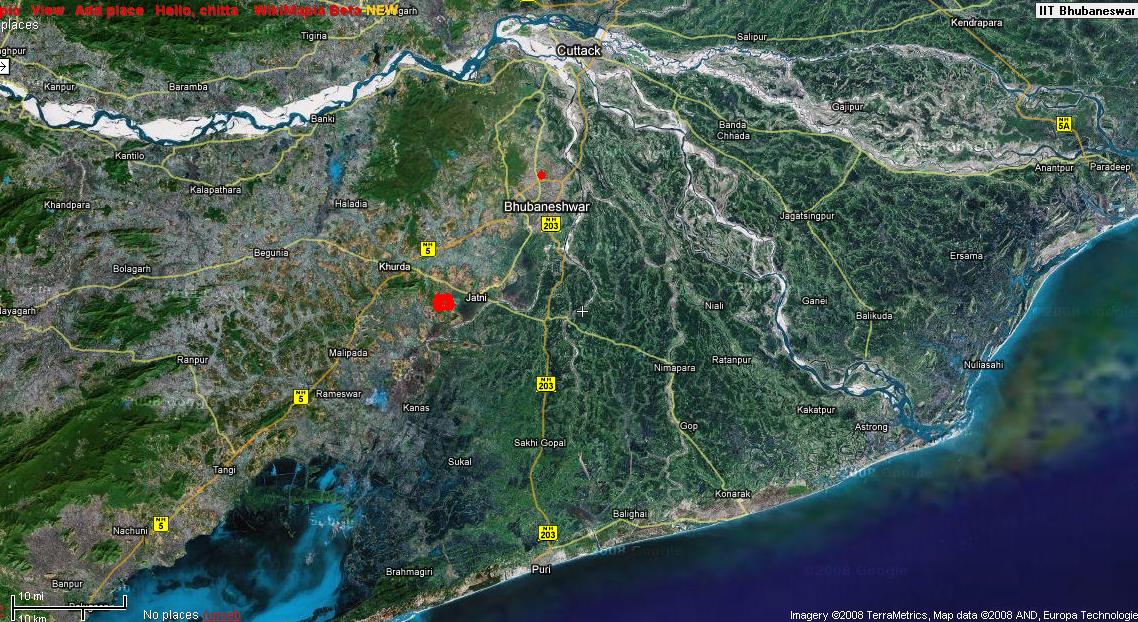
December 24th, 2008
Now that Koraput has been announced by the CM as well as in the assembly as the location for a central university, lets be happy about it. I know some of the other districts who wanted the central university to be there may have reasons to be unhappy. My suggestion to them, especially for people (and my friends) from Kalahandi, is to continue their efforts for a new central university and pursue other avenues such as a state university and a BPIET.
Now celebrating Koraput, following are some good aspects of Koraput.
- Koraput area is a cluster of several towns which could become a sizeable metropolitan area in the near future. As per the population numbers in this site and this site the towns around Koraput and their population are: Jeypore: 84,136 (20 km from Koraput); Koraput: 39,523; Sunabeda: 62,706 (20 km from Koraput); and Damanjodi: 8,475. The total may now surpass 200,000.
- The Kolab resorvoir is a picturesque area for a central university. The university is proposed to be between Koraput at Sunabeda on the bank of this resorvoir.
December 19th, 2008
The following is from Samaja.
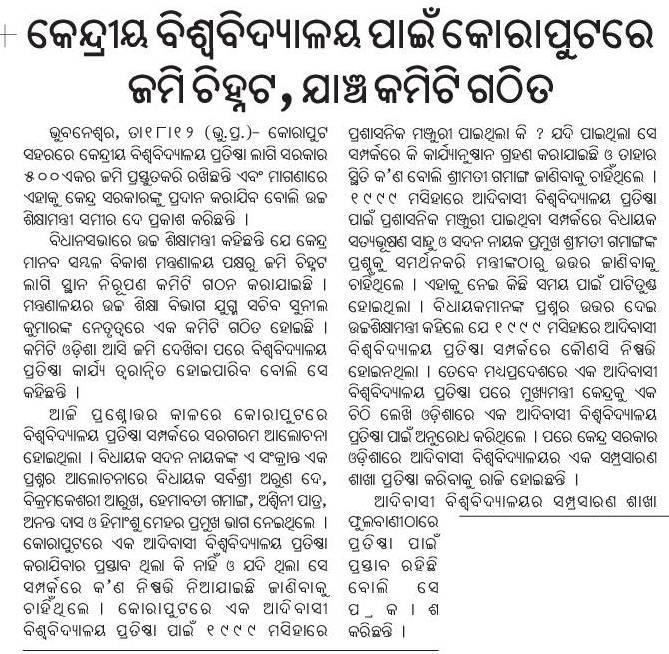
It is high time people of Kalahandi go to the CM for higher education institutes in Kalahandi. In particular they should demand a state university and a centrally funded BPIET (Biju Patnaik Inst of Engineering and Technology) in the line of SLIET and ABA Ghani Khan Choudhury IET. The people of Kalahandi need to be strategic in terms of what they can get at this time. For example, UCE Burla supporters initially, for several years, were going after a deemed university status. It was going very slowly. Once they switched to demanding for state unitary university status, things happened fast. Similarly, people of Kalahandi should realize that they should not put all their egg in one basket. IMHO, shifting of the location from Koraput to Kalahandi after the location is announced by the CM and mentioned in the assembly is unlikely, and I hope I am wrong, but a new central university in Kalahandi has a low chance of happening soon. So as a practical matter people of Kalahandi should, for now, ask for a state university and a BPIET. They don’t have to retract their demand for a central university; that can continue.
December 19th, 2008
Thanks to Debu for this.
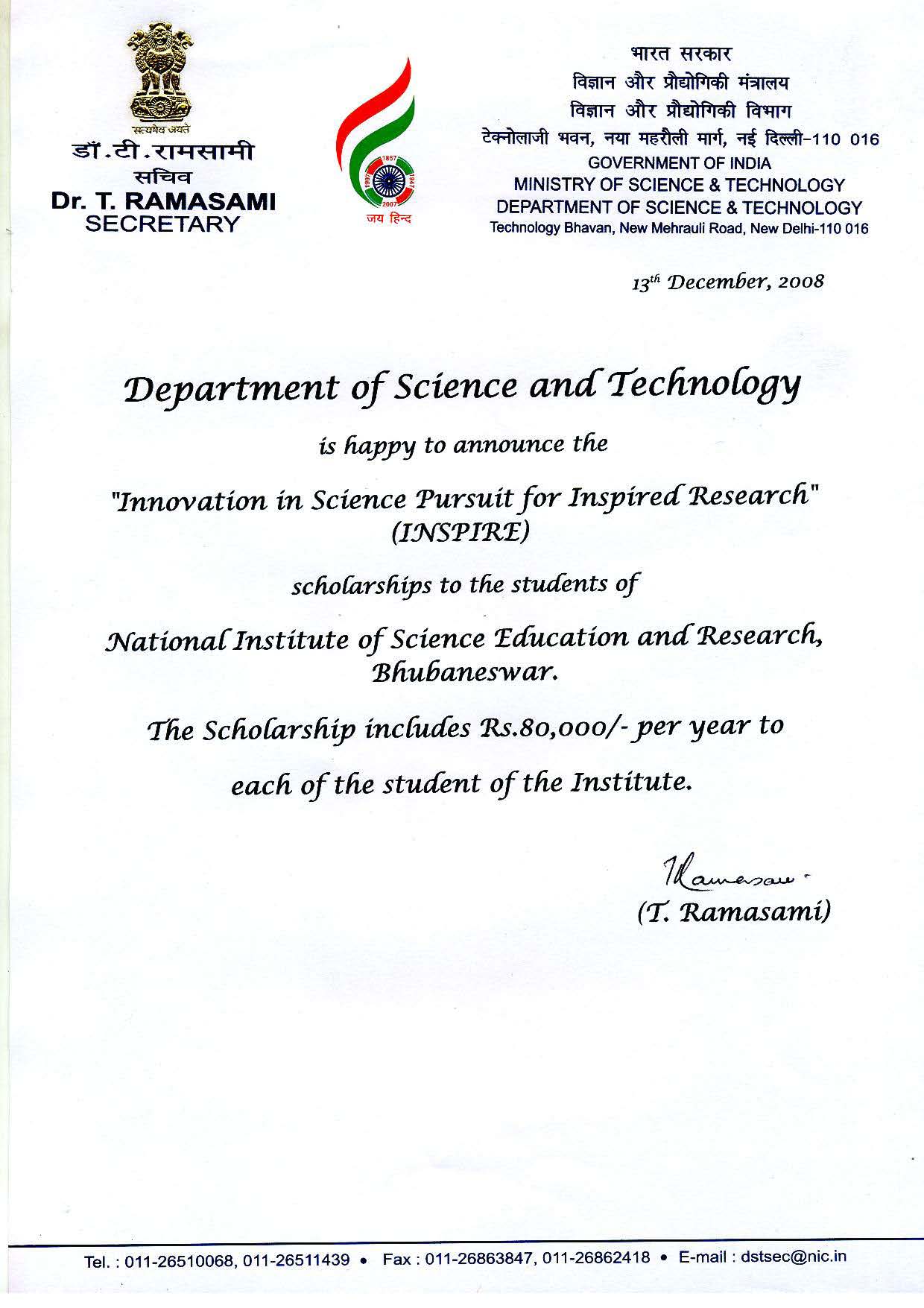
December 17th, 2008
Following is an excerpt from a report in Telegraph.
… The human resource development ministry has decided to open nine new NITs instead of 10, replacing the tenth with an institute to be named after A.B.A. Ghani Khan Choudhury.
The Union cabinet approved the Ghani Khan Choudhary Institute of Engineering and Technology on November 20, allocating Rs 97 crore for the project.
The institute will be based in Malda, the late Congress leader’s bastion.
… a cash-strapped government has quietly decided to scrap one NIT to accommodate the institute named after Choudhury without spending more.
… Unlike the NITs, which have a national character and admit students from across the country, the Ghani Khan Choudhary Institute will primarily cater to local students, sources said.
“It will not be an NIT and will not even be run like one. The idea, pushed by the late Congress leader’s family, was not to have a national institution but a memorial to Choudhury. And that’s what this institute will be,” a source close to HRD minister Arjun Singh said.
… The Ghani Khan Choudhary Institute will not be run by a central law.
Choudhury’s family members, it is learnt, have met Arjun at least twice to urge him to start the institute. A source in the Prime Minister’s Office confirmed that it, too, had been petitioned by the family.
…But the HRD ministry, the sources said, decided instead to propose the Ghani Khan Choudhary Institute in place of one NIT.
In 2009 if there is a friendly government in the Center Orissa should try for Biju Patnaik Instutute of Engineering and Technology along the above lines.
December 17th, 2008
Following is from http://pib.nic.in/release/release.asp?relid=45702.
The Government proposes to establish 14 National Universities aiming towards world-class standards the 11th Plan period. A State- wise list of cities identified or locating these universities is annexed. A preliminary draft of the Concept Paper on setting up of these universities was prepared by an Expert Committee constituted by the University Grants Commission. The Expert Committee has held extensive consultations with eminent educationists, academics and policy makers. The relevant recommendations of the National Knowledge Commission have also been taken into consideration by the Expert Committee while revising the draft Concept Paper. The Concept Paper is, however, yet to be finalized by the Committee.
|
SI.No.
|
Name of the State
|
Name of the City
|
|
1
|
Andhra Pradesh
|
Visakhapatnam
|
|
2
|
Assam
|
Guwahati
|
|
3
|
Bihar
|
Patna
|
|
4
|
Gujarat
|
Gandhinagar
|
|
5
|
Karnataka
|
Mysore
|
|
6
|
Kerala
|
Kochi
|
|
7
|
Madhya Pradesh
|
Bhopal
|
|
8
|
Maharashtra
|
Pune
|
|
9
|
Orissa
|
Bhubaneswar
|
|
10
|
Punjab
|
Amritsar
|
|
11
|
Rajasthan
|
Jaipur
|
|
12
|
Tamil Nadu
|
Coimbatore
|
|
13
|
Uttar Pradesh
|
Greater Noida
|
|
14
|
West Bengal
|
Kolkata
|
This information was given by Shri Arjun Singh, the Minister of Human Resource Development in a written reply to a question in the Lok Sabha today.
December 16th, 2008
Next Posts
Previous Posts







.jpg)





